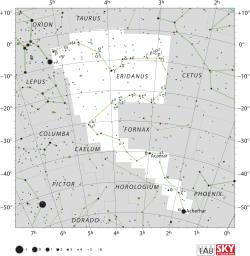15 Eridani
| 15 Eridani | |
 | |
| Observationsdata Epok: J2000.0 | |
|---|---|
| Stjärnbild | Eridanus |
| Rektascension | 03t 18m 22,10504s[1] |
| Deklination | -22° 30′ 40,0191″[1] |
| Skenbar magnitud () | 4,875[2] (6,57 / 5,32),[3] +4,875 ± 0,009 (V)[4] |
| Stjärntyp | |
| Spektraltyp | K0 III[5] |
| B–V | +0,904 ± 0,002[6] |
| Astrometri | |
| Radialhastighet () | +23,90 ± 0,5[7] km/s |
| Egenrörelse (µ) | RA: +13,08 ± 1,12[1] mas/år Dek.: +13,33 ± 1,51[1] mas/år |
| Parallax () | 12,77 ± 1,17[1] |
| Avstånd | 260 ± 20 lå (78 ± 7 pc) |
| Absolut magnitud () | +0,85[8] |
| Detaljer | |
| Massa | 2,32[9] M☉ |
| Radie | 10,19[10] R☉ |
| Luminositet | 72,4[9] L☉ |
| Temperatur | 4 960 ± 31[9] K |
| Metallicitet | +0,02 ± 0,06 (Fe/H)[10] dex |
| Ålder | 1,44[9] miljarder år |
| Andra beteckningar | |
| IRAS 03161-2241[11], 2MASS J03182211-2230400[11], HD 20610[11], HIP 15382[11], HR 994[11], SAO 168452[11], GSC 06439-01171[11], ADS 2463 AB[11], CCDM J03184-2231AB[11], GC 3955[11], GCRV 1829[11], HIC 15382[11], IRC -20040[11], PLX 689[11], PLX 689.00[11], PPM 246072[11], TD1 2079[11], TYC 6439-1171-1[11], UBV 3204[11], WDS J03184-2231AB[11], YZ 112 1541[11], WEB 2959[11], Gaia DR2 5099265828450228864[11], 15 Eri, 1RXS J031820.2-223052[11], Gaia DR3 5099265828450228864[11], TIC 92251085[11] och IDS 03140-2253 AB[11] | |
15 Eridani, som är stjärnans Flamsteed-beteckning, är en dubbelstjärna[3] belägen i den mellersta delen av stjärnbilden Eridanus. Den har en kombinerad skenbar magnitud på ca 4,88[2] och är svagt synlig för blotta ögat där ljusföroreningar ej förekommer. Baserat på parallaxmätning inom Hipparcosuppdraget på ca 12,8[1] mas, beräknas den befinna sig på ett avstånd på ca 260 ljusår (ca 78 parsek) från solen. Den rör sig bort från solen med en heliocentrisk radialhastighet av ca 24 km/s.[7]
Egenskaper
[redigera | redigera wikitext]Primärstjärnan 15 Eridani A är en orange till gul jättestjärna av spektralklass K0 III,[3] som ingår i röda klumpen,[12] befinner sig på den horisontella jättegrenen och genererar energi genom termonukleär fusion av helium i dess kärna. Den har en massa som är ca 2,3[9] solmassor, en radie som är ca 10[10] solradier och utsänder ca 72[9] gånger mera energi än solen från dess fotosfär vid en effektiv temperatur av ca 5 000 K.[9]
15 Eridani är en dubbelstjärna som har en omloppsperiod på 118,16 år med en excentricitet på 0,030 och en halv storaxel på 0,340 bågsekunder.[3] Följeslagaren, 15 Eridani B, är en stjärna av skenbar magnitud 6,57.[13]
Referenser
[redigera | redigera wikitext]- Den här artikeln är helt eller delvis baserad på material från engelskspråkiga Wikipedia, 15 Eridani, 7 mars 2021.
Noter
[redigera | redigera wikitext]- ^ [a b c d e f] van Leeuwen, F.; et al. (2007). "Validation of the new Hipparcos reduction". Astronomy and Astrophysics. 474 (2): 653–664. arXiv:0708.1752. Bibcode:2007A&A...474..653V. doi:10.1051/0004-6361:20078357. S2CID 18759600.
- ^ [a b] Høg, E.; et al. (2000). "The Tycho-2 catalogue of the 2.5 million brightest stars". Astronomy and Astrophysics. 355: L27–L30. Bibcode:2000A&A...355L..27H.
- ^ [a b c d] "Sixth Catalog of Orbits of Visual Binary Stars". United States Naval Observatory. Hämtad 11 augusti 2017.
- ^ ”Basic data: V* 15 Eri – Double or multiple star” (på engelska). Centre de Données astronomiques de Strasbourg. https://simbad.u-strasbg.fr/simbad/sim-basic?Ident=15+Eri&submit=SIMBAD+search. Läst 6 juli 2020.
- ^ Houk, N.; Smith-Moore, M. (1988). "Michigan Catalogue of Two-dimensional Spectral Types for the HD Stars. Volume 4, Declinations -26°.0 to -12°.0". Michigan Catalogue of Two-dimensional Spectral Types for the HD Stars. 4. Bibcode:1988mcts.book.....H.
- ^ van Leeuwen (2007). ”Hipparcos, the New Reduction” (på engelska). https://vizier.u-strasbg.fr/viz-bin/VizieR-5?-out.add=.&-source=I/311/hip2&HIP=15382. Läst 6 juli 2020.
- ^ [a b] Kharchenko, N. V.; et al. (2007). "Astrophysical supplements to the ASCC-2.5: Ia. Radial velocities of ~55000 stars and mean radial velocities of 516 Galactic open clusters and associations". Astronomische Nachrichten. 328 (9): 889. arXiv:0705.0878. Bibcode:2007AN....328..889K. doi:10.1002/asna.200710776. S2CID 119323941.
- ^ Ammler-von Eiff, M.; Reiners, A. (June 2012), "New measurements of rotation and differential rotation in A-F stars: are there two populations of differentially rotating stars?", Astronomy & Astrophysics, 542: A116, arXiv:1204.2459, Bibcode:2012A&A...542A.116A, doi:10.1051/0004-6361/201118724, S2CID 53666672.
- ^ [a b c d e f g] Luck, R. Earle (2015). "Abundances in the Local Region. I. G and K Giants". Astronomical Journal. 150 (3). 88. arXiv:1507.01466. Bibcode:2015AJ....150...88L. doi:10.1088/0004-6256/150/3/88. S2CID 118505114.
- ^ [a b c] ”15 Eridani” (på engelska). Universe Guide. https://www.universeguide.com/star/15eridani. Läst 6 juli 2020.
- ^ [a b c d e f g h i j k l m n o p q r s t u v w x y z aa] SIMBAD Astronomical Database.[källa från Wikidata]
- ^ Alves, David R. (August 2000), "K-Band Calibration of the Red Clump Luminosity", The Astrophysical Journal, 539 (2): 732–741, arXiv:astro-ph/0003329, Bibcode:2000ApJ...539..732A, doi:10.1086/309278, S2CID 16673121
- ^ Eggleton, P. P.; Tokovinin, A. A. (September 2008). "A catalogue of multiplicity among bright stellar systems". Monthly Notices of the Royal Astronomical Society. 389 (2): 869–879. arXiv:0806.2878. Bibcode:2008MNRAS.389..869E. doi:10.1111/j.1365-2966.2008.13596.x. S2CID 14878976.





